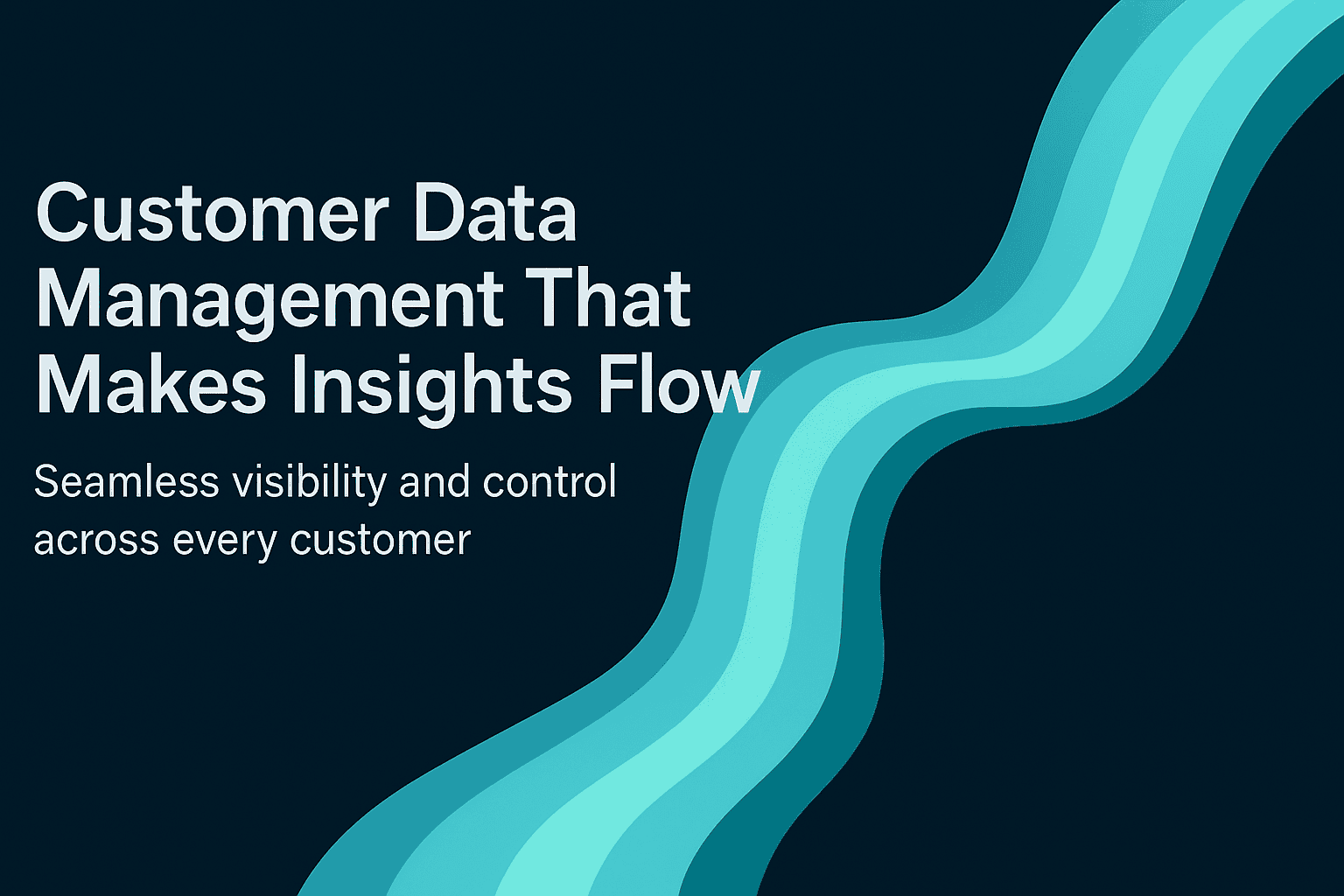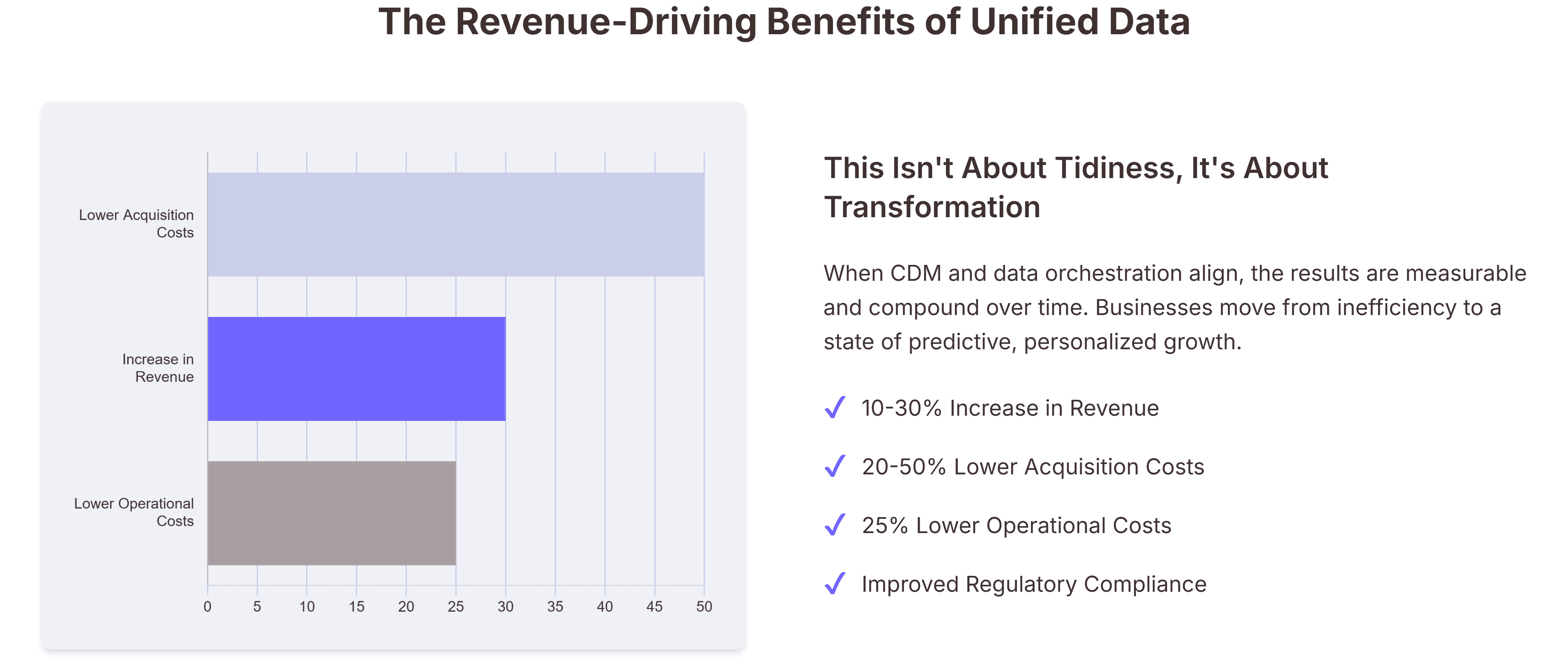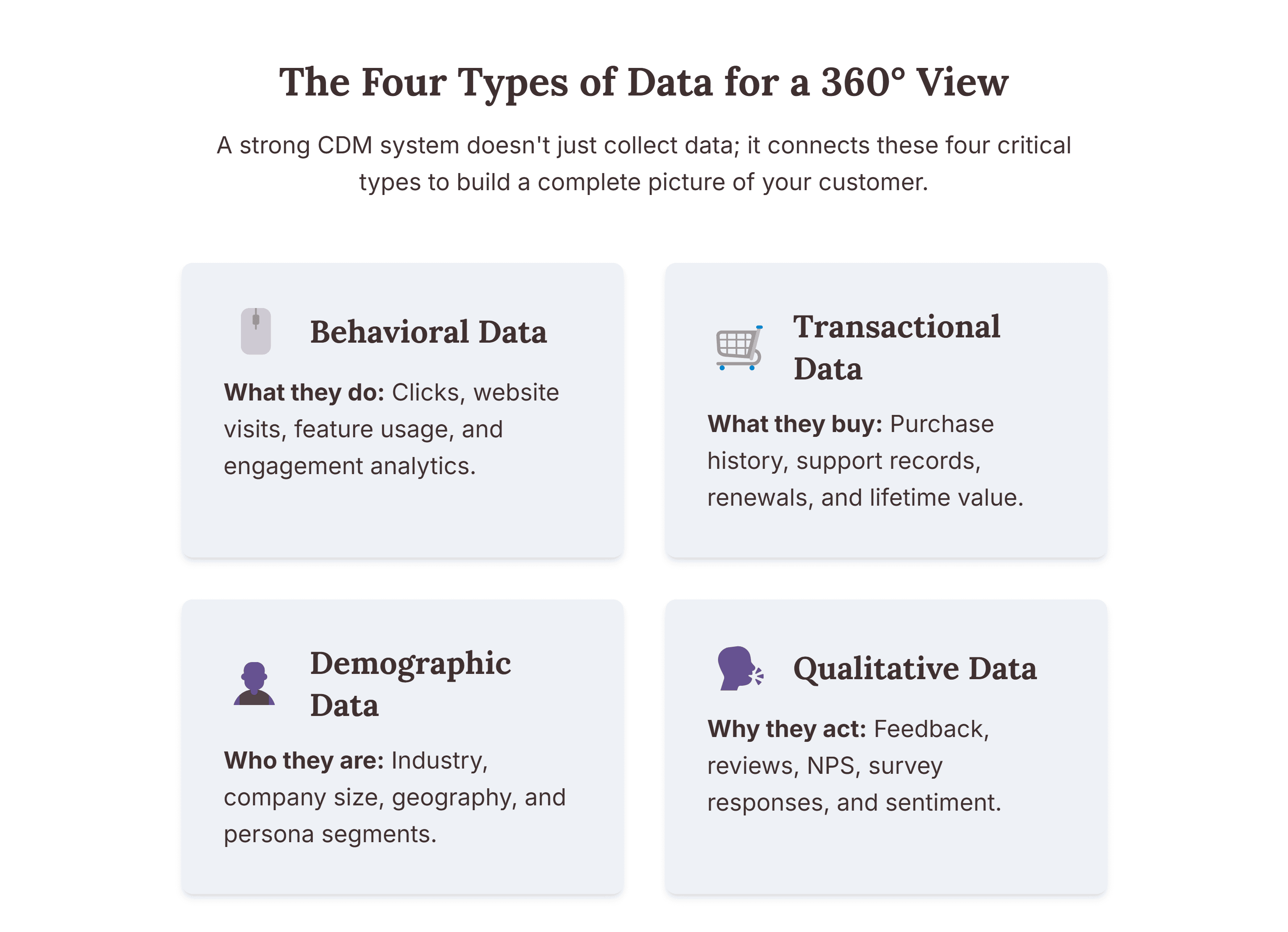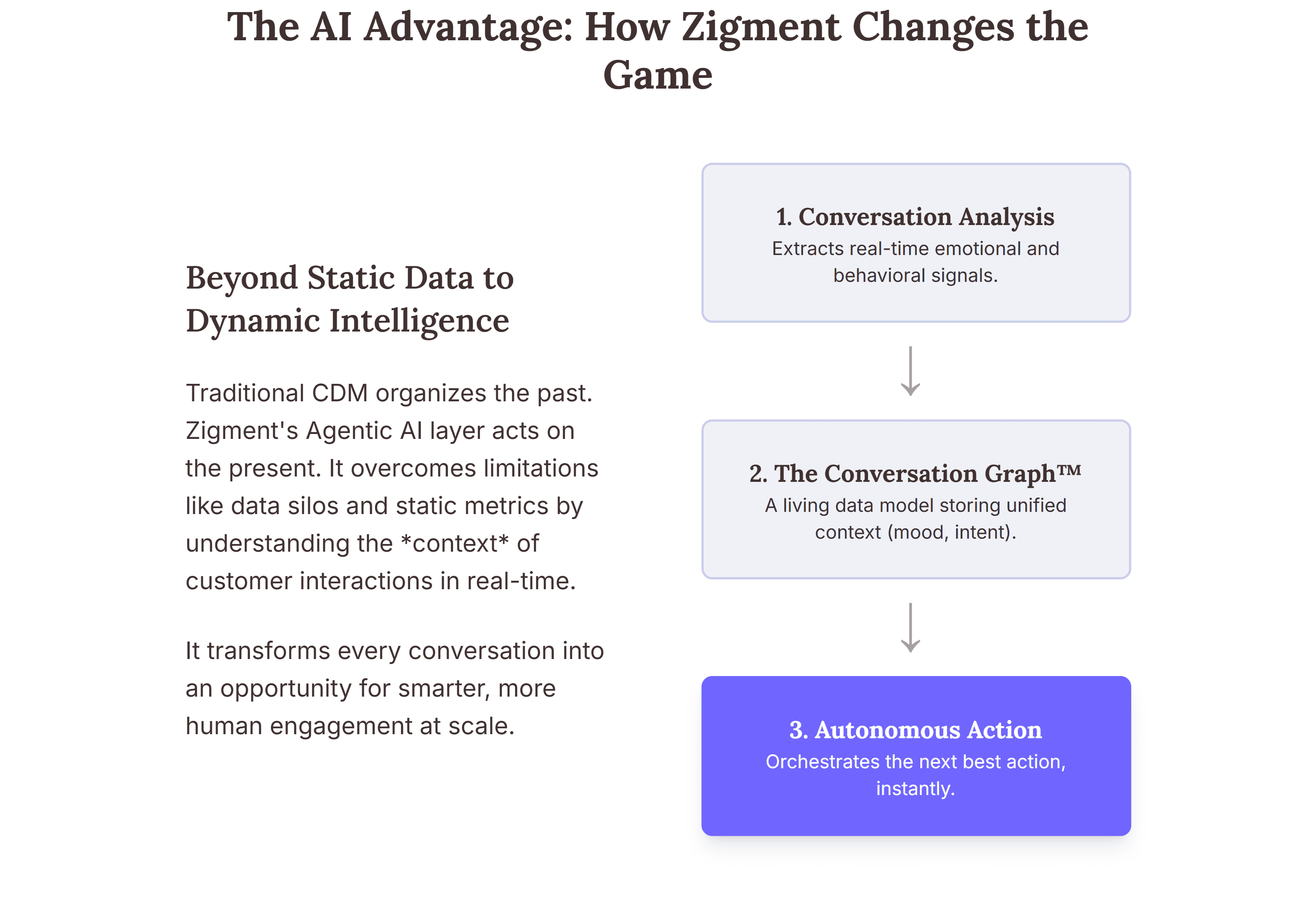Customer Data Management: Benefits, Types, and Key Challenges

“The best time to fix your customer data was five years ago. The second-best time is now.”
Here’s a painful truth: most organizations have multiple versions of the same customer scattered across systems.
One record lives in the CRM, another in the billing software, a third in the marketing automation tool and none of them agree.
This chaos doesn’t just waste time, it costs money!
Gartner estimates that data silos cost businesses $15 million annually, and 82% of those losses are preventable with effective customer data management.
Without it, your company isn’t just inefficient, it's flying blind through a digital storm.
What Is Customer Data Management?
Customer data management (CDM) is the structured process of collecting, organizing, governing, and activating customer information across all touchpoints. The goal is to build unified customer data with a single, accurate profile for every individual.
Think of CDM as the bridge between insight and action. When paired with data orchestration, it ensures every data flow from CRM to marketing, from e-commerce to analytics moves in harmony.
With proper customer data management, organizations can:
Build a single source of truth across systems
Access real-time, accurate customer information
Personalize journeys that actually convert
Ensure regulatory compliance (GDPR, CCPA, etc.)
Improve operational efficiency through database orchestration
“Good data doesn’t just inform decisions, it empowers smarter, faster ones.”
Why Unified Customer Data Delivers Real Revenue?
“If your strategy depends on fragmented data, your results will be fragmented too.”
Customer data management isn’t about tidiness, it's about transformation.
Without unified customer data management, teams work in silos, marketing wastes spend, and analytics misfire. But when data orchestration aligns systems, every team speaks the same language of truth.
What is the cost of ignoring integration?
40% of marketing budgets wasted on the wrong audience
Missed upsell opportunities
Frustrated customers due to inconsistent experiences
Regulatory risk from mishandled information
When companies embrace customer data integration
25% lower operational costs
10–30% increase in revenue from personalization
20–50% lower acquisition costs

The Four Types of Customer Data Your Business Can’t Function Without
A strong customer data management system unites four critical types of data:
Behavioural Data – What customers do: website visits, clicks, downloads, feature usage. When orchestrated across platforms, this data powers journey analytics and engagement scoring, helping businesses anticipate customer needs in real time.
Transactional Data – What customers buy: purchase history, renewals, support records. By integrating this data into a unified customer model, companies can track spending behavior, identify high-value customers, and forecast lifetime value — all key to driving retention and revenue growth.
Demographic Data – Who customers are: industry, company size, geography, and persona segments. This data enables precise targeting and audience segmentation, allowing marketing and sales teams to craft campaigns that resonate with each persona or region.
Qualitative Data – Why customers act: feedback, reviews, NPS, and surveys that explain motivations behind behaviour. This data adds human context to numbers, helping teams refine messaging and improve product experiences.
Together, these datasets create a 360° customer view. Customer data integration ensures these aren’t just collected, but connected.

What Customer Data Management Fixes — And Where It Falls Short
Let’s get real. CDM fixes a lot, but not everything.
What CDM fixes:
Data silos and conflicting records
Inefficient, manual processes
Poor personalization and fragmented experiences
Compliance vulnerabilities
Lack of real-time insights
Where CDM falls short:
It won’t fix unclear strategy or poor leadership buy-in
It won’t create a data-driven culture on its own
It’s not a magic bullet for broken processes
Customer data management gives you the ingredients but data orchestration is the chef ensuring everything works together in perfect timing.
“Data management organizes; orchestration operationalizes.”
The Hidden Cost of Fragmented Data
Picture this: Your marketing team just sent a "Come back!" discount to someone who purchased yesterday. Your support agent has no idea the customer complained on social media an hour ago. Your sales team is chasing a lead who's already deep in the buying journey.
Sound familiar?
You've invested in cutting-edge CRMs, personalization engines, and analytics platforms. But here's the brutal truth: without data orchestration, you're running a digital circus, not a business.
Fragmented data isn't just annoying , it's expensive!
Every misaligned touchpoint chips away at trust. Every duplicate record wastes time. Every disconnected system creates blind spots that competitors exploit.
You can invest in the most advanced CRM or personalization platform, but without data orchestration, you’re still stuck in chaos.
Imagine sending promotional emails to customers who’ve already purchased, or recommending products irrelevant to their history because your tools can’t communicate.
That’s what happens when customer data integration is missing.
Data orchestration acts as the conductor, ensuring each system plays its role harmoniously and in sync. It eliminates duplicate records, automates syncs, and guarantees that marketing, sales, and support all pull from the same unified dataset.
The result?
Smarter campaigns, lower churn, and customers who feel understood!
The question isn't whether you need data orchestration. It's how much longer you can afford to operate without it.
Four Essential Components That Make Customer Data Management Work
“Integration without governance is noise; governance without activation is silence.”
Every effective CDM initiative stands on four pillars:
Customer Data Integration Infrastructure – This is the backbone of CDM — the pipelines that connect all your systems, from CRM and analytics tools to marketing platforms. It enables real-time synchronization and smooth data orchestration, ensuring every update reflects instantly across the organization.
Customer Master Database – Acting as the single source of truth, this unified database consolidates customer information from multiple touchpoints. It blends transactional and behavioural data, creating a complete 360° customer profile that supports smarter engagement strategies.
Data Governance Framework – Governance defines the rules of the game. It establishes policies for security, accuracy, privacy, and compliance, ensuring your data remains trustworthy and protected. This layer keeps your CDM ecosystem healthy and audit-ready.
Activation Layer – The final stage where data meets action. Clean, unified data powers marketing automation, personalized campaigns, and predictive analytics driving meaningful customer interactions and measurable business results.
Together, these elements transform scattered databases into a strategic intelligence ecosystem.
The Bottom Line: Manage Data or Be Managed by It
Customer data management is no longer optional , it’s a growth engine powered by data orchestration and integration.
By building a foundation of unified customer data, businesses unlock personalization, predictive analytics, and consistent experiences that drive loyalty.
Start small. Audit your current systems. Identify data silos. Then design your own orchestration strategy to connect it all.
Because in the era of intelligent business, the companies that master customer data management aren’t just surviving; they're soaring with visibility, precision, and control.
“You can’t orchestrate success with broken instruments. Start by tuning your data.”
From CDM to Agentic AI — A Smarter Way Forward
Traditional customer data management hits a wall when it matters most!
Traditional customer data management (CDM) often faces critical limitations:
Information Silos: Data is scattered across systems, making it hard to form a single view of the customer.
Static Metrics: Conventional dashboards rely on lagging indicators that miss the nuances of real-time interactions.
Lack of Context: Qualitative signals like customer mood, sentiment, and intent are rarely captured or understood.
Zigment overcomes these challenges by acting as an layer on top of your data ecosystem.

It brings:
Conversation Analysis: Extracts real-time emotional and behavioural signals from every interaction.
The Conversation Graph: A living data model that stores unified context connecting customer mood, intent, and journey insights.
Autonomous Action: With this context, intelligent agents can instantly orchestrate the next best action, enabling true personalization at scale.
Zigment transforms static data into dynamic intelligence turning every conversation into an opportunity for smarter, more human customer engagement.